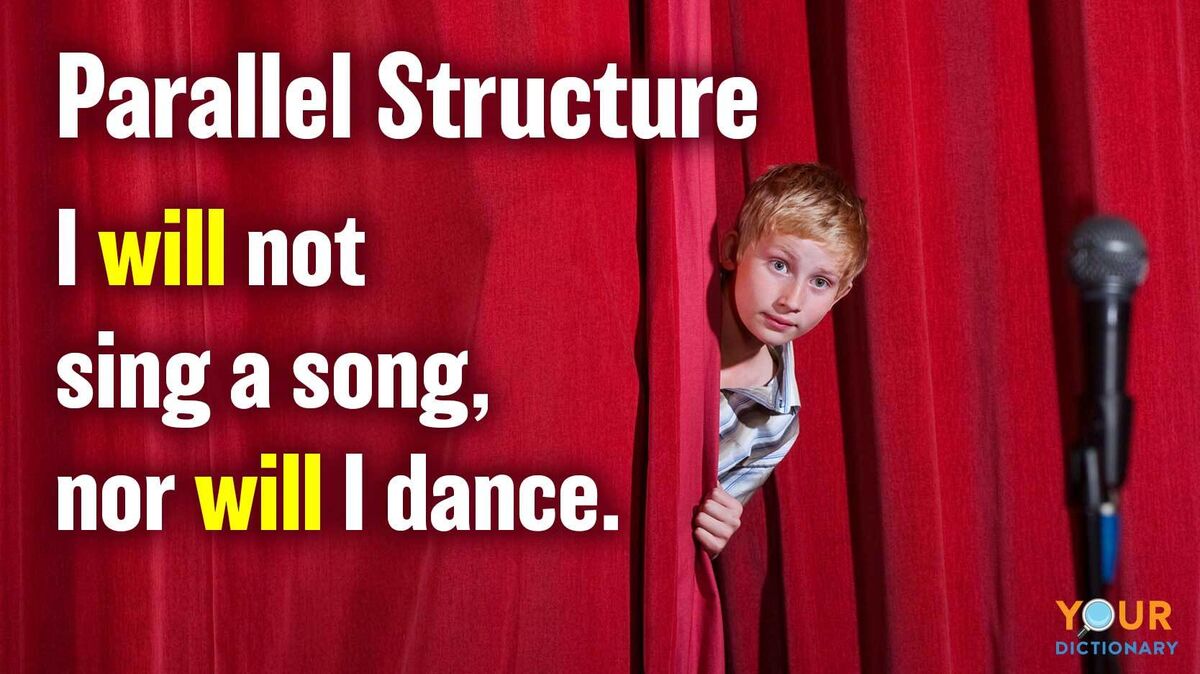
Parallel structure, or parallelism, means using the same pattern of words to show that two or more words or ideas are of equal importance. Words and phrases within a sentence should not only match in structure, but also in tense. Writers use parallel structure to add clarity to their writing, make it easier to understand and show that their writing is structurally and grammatically correct. Explore parallel structure examples to better understand the concept.
Parallel Structure With Coordinating Conjunctions
Parallel structure should be used when you connect clauses with a coordinating conjunction such as: for, and, nor, or, but, so, or yet in a sentence.
Correct Examples
The words that indicate parallel construction are marked in bold.
- Every morning, we make our bed, eat breakfast and feed the dog.
- I will not sing a song, nor will I dance.
Incorrect Examples
The terms that should be parallel, but are not, are italicized.
- Every morning, we make our bed, eating breakfast and feed the dog. ("Eating" does not match "make" or "feed" in structure.)
- I will not sing a song, nor dance. (tThe writer used "will" with "not," so also needs to use "will" with nor.)
Parallel Structure With Correlative Conjunctions
Parallel structure is also used with correlative conjunctions, such as either ... or, neither ... nor, not only ... but also.
Correct Examples
The words that indicate parallel construction are marked in bold.
- They argued not only about the article but also about the review.
- Either she likes to see him or she doesn't like to see him.
Incorrect Examples
The errors in the following examples are italicized.
- They argued not only about the article, but they argued also about the review. (The phrase "they argued" should not be here; it keeps the second part of the sentence from being parallel with the first.)
- Either she likes to see him or doesn't like seeing him. ("Likes to see" should be used with "doesn't like to see" or "doesn't like to see" should be used with "likes to see", but the two structures shouldn't be mixed. )
Parallel Structure With Infinitives
Parallel structure should be used with infinitives.
Correct Examples
The terms that indicate parallel structure are marked in bold.
- Ashley likes to ski, to swim and to jump.
- She likes to dance and to sing songs.

Incorrect Examples
The problematic areas are italicized below.
- Ashley likes to ski, to swim and jump. (There needs to be a "to" between "and" and "jump," to be parallel with the other items. )
- She likes dancing and to sing songs. (This should pair "to dance" with "to sing" so the infinitive form is used throughout the sentence.)
Parallel Structure With -ing Endings
Be consistent and use parallel structure with words that end in -ing.
Correct Examples
The bold words indicate that parallel construction is used correctly.
- Joe likes running, walking and being active.
- We enjoy relaxing and sitting out in the sun.
Incorrect Examples
The words that should be parallel but aren't are shown in italics here.
- Joe likes running, walking and outdoor activities. ("Running" and "walking" are parallel with each other, but "outdoor activities" is not parallel. Use "participating in outdoor activities" or similar.)
- We enjoy relaxing and like to sit out in the sun. (The italicized phrases are not parallel; they should both include verbs that end in -ing.)
Parallel Structure With Clauses
Parallel structure should be used when writing clauses.
Correct Examples
The bold terms illustrate parallel construction between the clauses.
- The teacher told them that they need to study and that they should practice their words every night.
- My parents said get a good education and do not settle for less.
Incorrect Examples
In these examples, the clauses do not illustrate parallel construction. The problem wording is highlighted.
- The teacher told them to study and that they should practice their words every night. (This sentence should either include "that they" in both clauses, like the correct example above, or it should include the word "said" between "that" and "they.")
- My parents said to get a good education and not settle for less. (Here, the word "to" should be included before "not" in the italicized text.)
Parallel Structure in Lists With Colons
When you have items on a list following a colon, the items should all be in the same form in order to avoid a parallel structure error.
Correct Examples
Wording that indicates parallel construction in these examples is bold.
- The following activities can be done at the mall: buying groceries, eating lunch and paying bills.
- In your bedroom, you will find the following: a bed, a closet and a desk.
Incorrect Examples
The problematic wording in these examples is highlighted in italics.
- The following activities can be done at the mall: buying groceries, eating lunch and bill payment. ("Bill payment" should be written as "paying bills" in order to show parallel construction.)
- In your bedroom, you will find the following: a bed, a closet and, sitting at a desk. (You shouldn't list two nouns with an activity in this type of list. It could read, "a bed, a closet, and a desk if that is what the writer means. If the writer wants to describe someone sitting at a desk, that should be part of a new sentence. )
Parallel Structure in Other Lists
Even when a colon isn't used to introduce a list, parallel construction is important.
Correct Examples
The terms that form parallel structure in these sentences are bold.
- Mary wanted to make sure that she made her presentation creatively, effectively and persuasively.
- Tim was considered to be a good employee because he was always on time, he was very motivated and he was a good leader.
Incorrect Examples
Parallel constructor errors are italicized.
- Mary wanted to make sure she made her presentation creatively, effectively and persuaded others. ("Persuaded others" is not parallel with the other list items.)
- Tim was considered to be a good employee because he was always on time, he was very motivated and led the team well. ("Led the team well" is not parallel with the other list items.)
Parallel Structure in Verb Tense
Keep in mind that parallel structure should be used when it comes to verb tense. Your verb tenses should always match.
Correct Examples
The bold words in these examples are all past tense, which means they are examples of parallel construction.
- She wrote a letter and mailed it to the school.
- Yesterday we watched a movie, played video games and made pizza.
Incorrect Examples
The examples below mix tenses. The problematic wording is italicized.
- She writes a letter and mailed it to the school. (This mixes present and past tense; both words should be the same tense.)
- Yesterday we watched a movie, play video games and made pizza. ("Watched" and "made" are past tense, but "play" is present tense. It should be "played" since the sentence specifies this took place in the past.)
The Importance of Parallel Structure
Parallel structure provides flow in a sentence. It keeps your writing balanced and makes it easier to read. It also shows that ideas are of equal importance. Errors in parallel structure can make your writing sound strange to listeners. Many tests, including the SAT, will require you to identify parallel structure errors as a means of testing your writing abilities. To further expand your knowledge about parallel structure in writing, review these examples of parallelism in literature and rhetoric.